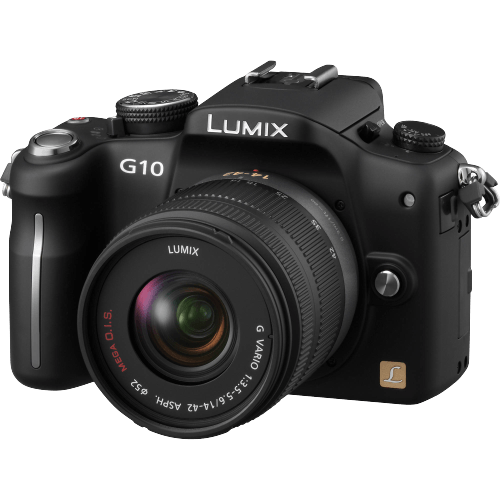Panasonic Lumix DMC G10 Specs and Scores

The Panasonic Lumix DMC G10 receives a score of 40/100, which reflects its general specifications. This mirrorless camera was announced on March 7, 2010, and released the same year at a launch price of $600. Measuring 124 x 90 x 74mm and weighing 388g (0.86lbs), the G10 has a compact and lightweight design.
Considering today’s market, this camera’s specifications are outdated, and its score is lower than modern alternatives. While the G10 was a decent option back in 2010, there are now more advanced options available for photographers.
Panasonic Lumix DMC G10 Overview and Optics
The Panasonic Lumix DMC G10 receives a score of 44/100 for optics. The camera possesses 12.1 megapixels, a shooting speed of 3.2, and a CMOS sensor. The Venus Engine HD II processor powers the camera, while the DXOMARK score for the sensor is 52. The sensor size is Micro Four Thirds, and the lens mount is Micro 4/3. The camera also features image stabilisation and a 4:3 aspect ratio.
In the current market, the Lumix DMC G10’s specifications may not meet the expectations of advanced photographers. For instance, the 12.1-megapixel resolution may be insufficient for those seeking high-quality images with intricate details. The shooting speed of 3.2 is also relatively slow, which could be a limitation for capturing fast-moving subjects. Furthermore, the 52 DXOMARK score is below average compared to more recent camera models.
The Panasonic Lumix DMC G10 is an entry-level camera with basic optics specifications. It may be suitable for casual users or beginners in photography but may not satisfy the needs of more experienced photographers. The camera’s score of 44/100 reflects its limited capabilities in the optics department.
Panasonic Lumix DMC G10 Video Performance
The Panasonic Lumix DMC G10 receives a video score of 34 out of 100. This camera offers a maximum video resolution of Standard HD, with dimensions of 1280 x 720 pixels. The frame rate reaches up to 30 frames per second, providing decent video quality.
Comparing the video capabilities of the Lumix DMC G10 to today’s market, it falls short in terms of resolution and features. Many modern cameras offer Full HD or 4K video resolutions, and come with built-in time-lapse functionality. Unfortunately, the Lumix DMC G10 does not have this time-lapse feature.
Considering the video specifications and the current market standards, the Panasonic Lumix DMC G10’s video capabilities are not on par with its competitors. It is a decent option for those who prioritize photography over videography, but for users who require advanced video features, other cameras may be more suitable.
Panasonic Lumix DMC G10 Features and Benefits
The Panasonic Lumix DMC G10 scores 36 out of 100 in the features department. This score reflects the camera’s limited and outdated specifications compared to current market offerings. The G10 has a 3-inch screen with a resolution of 460,000 dots, which is notably lower than most modern cameras. Additionally, it lacks touchscreen functionality, a flip screen, GPS, WiFi, and Bluetooth connectivity.
These missing features highlight the G10’s limitations and its inability to compete with more advanced camera models on the market today. With the absence of modern features, potential buyers may find the G10 less appealing and opt for cameras with better connectivity and usability options. Despite its shortcomings, the Panasonic Lumix DMC G10 still offers a reliable performance for those who prioritize basic photography functions over advanced features.
Panasonic Lumix DMC G10 Storage and Battery
The Panasonic Lumix DMC G10 receives a storage and battery score of 21 out of 100. This camera offers one memory card slot, accepting SD, SDHC, and SDXC cards. While these memory card options are standard in the market, the single slot may be limiting for some users. The G10’s battery life provides 380 shots per charge, which is below average compared to other cameras in its class. The camera uses a DMW-BLB13PP battery type, but it does not support USB charging.
Considering the storage and battery specifications, the Panasonic Lumix DMC G10 falls short in today’s competitive camera market. Its limited memory card slots and below-average battery life may not meet the needs of demanding photographers.
